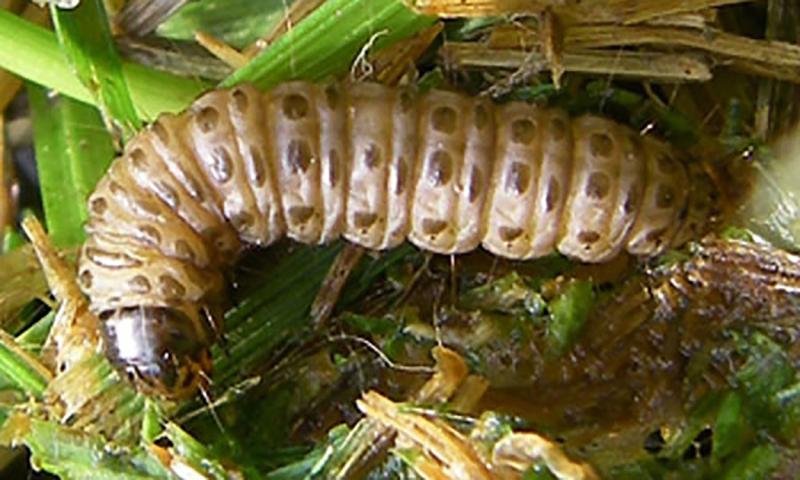Originally Submitted: July 18, 2022
Sod webworm moths have been very active during the last couple of weeks. These small moths are just an indicator of the potential for lawncare issues to come. Sod webworm caterpillars are typically a minor pest of turf grass in South Dakota. However, hot, dry conditions like those observed during 2021, and now being experienced in 2022, have left many lawns in an already stressed state, which makes them more susceptible to damage from sod webworm activity.
Identification and Biology

Sod webworm moths are ½ to 1 inch long, depending on the species. Their wings are dull white or gray with a delicate fringe along the edges of the hindwings. Some species can also have a pattern of dark stripes present on the wings (Figure 1). The moths have long snouts and hold their wings in a tube-like position over their bodies while at rest. Most sod webworm larvae (caterpillars) grow ¾ to 1 inch long and are brown or gray in color. They have dark spots and coarse hairs on their bodies and their heads are solid brown (Figure 2).
Overwintering larvae become active in the spring and start feeding on grass blades and stems near the soil surface. Larvae molt several times and then pupate in late spring or early summer. Sod webworm moths emerge several days later to mate and lay eggs in lawns. A second or third generation may occur until fall when colder weather sets in. Cold temperatures cause the larvae to form web-like chambers in the thatch layer of lawns, where they overwinter until the following spring.
Scouting

Sod webworm larvae feeding is first characterized by the observation of small patches in lawns that have a ragged, brown appearance. These areas will often look like they were scalped with minimal amounts of grass present. These areas should be focused on to determine if larvae, silk tubes or webbing are present. During a dry year, or when pets are in a yard, these spots may be mistaken for drought stress or pet damage.
Sod webworm damage is characterized by lawns looking thin, drought-stressed or having dead patches in more-severe cases.
Management
Most lawns can tolerate the larval feeding as it occurs during peak growth periods of the grass. Consistent watering and fertilizer applications can help lawns recover quickly and outgrow webworm feeding injury. Sod webworm activity during hot weather with drought conditions can lead to large areas of lawns being killed. Typically, during drought conditions, lawn watering isn’t recommended for established lawns, but it may be necessary. Check with local municipalities to determine if there are any watering restrictions in your area.
Birds often play a large role in managing webworm populations, as they will feed on both the developing larvae in the grass as well as the adult moths flying in the air. The use of insecticides for sod webworms should be a last resort and is not necessary unless there are back-to-back years of abundant populations. For healthy lawns, 15 or more sod webworm larvae per square yard is the threshold for insecticidal treatment. However, there isn’t a set threshold for stressed lawns, but it is known that much fewer larvae can cause significant damage when other stressors are present (i.e. drought).


